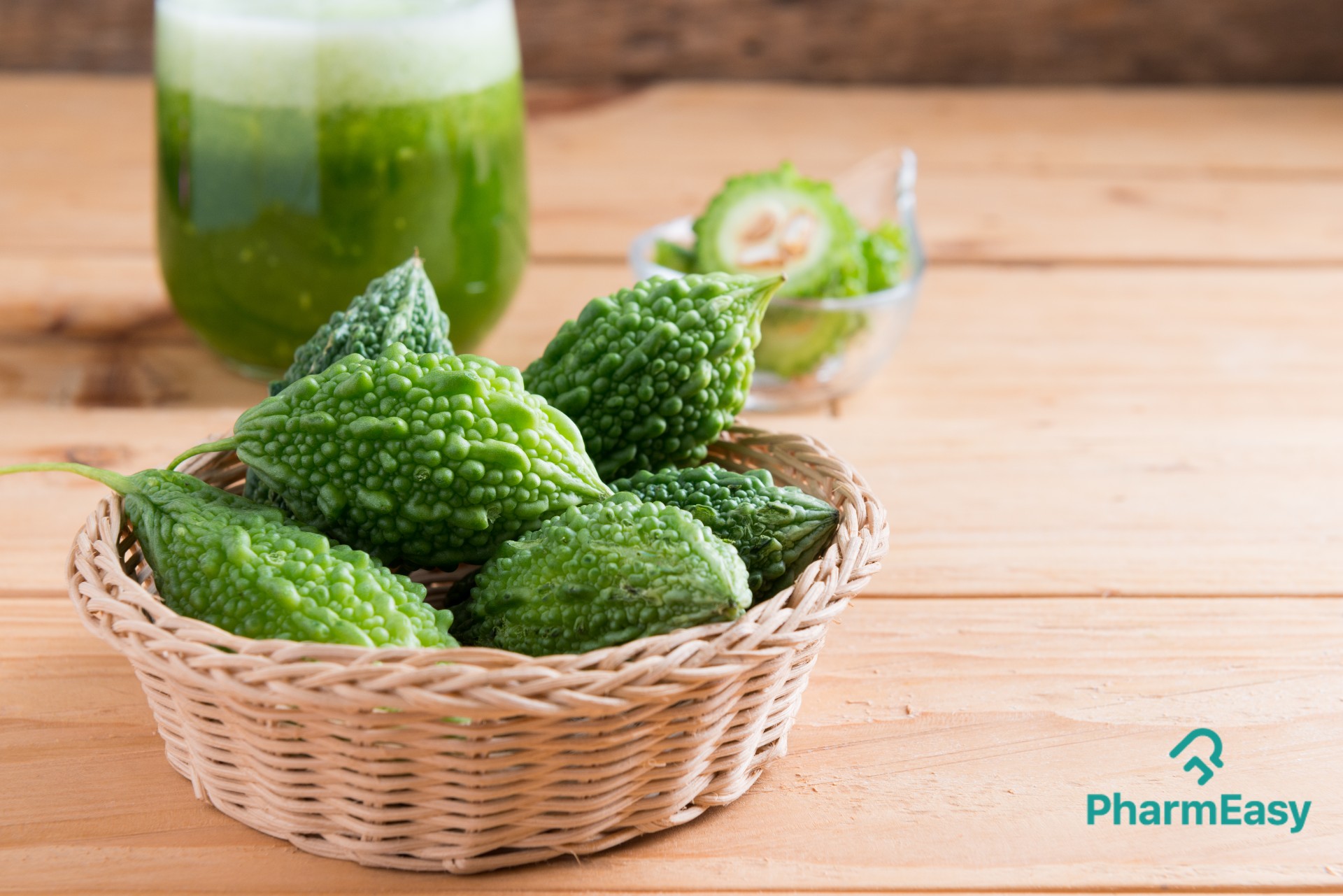Karela (Bitter Gourd): Uses, Benefits, Side Effects and More!
By Dr Anuja Bodhare +2 more

Get,

to manage your symptom
Get your,


4 Cr+ families
benefitted

OTP sent to 9988776655



You’ve successfully subscribed to receive
doctor-approved tips on
Whatsapp

Get ready to feel your best.

Hi There,
Download the PharmEasy App now!!


Register to Avail the Offer
Send OTPBy continuing, you agree with our Privacy Policy and Terms and Conditions

Hi There,
Sign up on PharmEasy now!!
Trusted by 4 crore+ families

OTP sent to 9988776655



You have unlocked 25% off on medicines




Code: NU25

Comments


Leave your comment here
By Dr Anuja Bodhare +2 more
Table of Contents
Karela, also known as Momordica charantia L., belongs to the family Cucurbitaceae. It is commonly known as balsam pear, bitter gourd, bitter melon, karela, or kugua. Its fruit has been used as a vegetable for thousands of years. It is widely distributed in tropical and subtropical regions worldwide. It is called ‘bitter melon’ or ‘bitter gourd’ as the entire plant, including the fruit, tastes very bitter. Karela is widely cultivated in India, China, Japan, Malaya, Thailand, Vietnam, Singapore, Colombia, Brazil, Amazon, Cuba, East Africa, Haiti, Ghana, Mexico, Nicaragua, New Zealand, Panama, the Middle East, the Central and South America1.
The vernacular names of Karela are Karavelli in Sanskrit; Karelo in Gujrati; Karli in Marathi; Baramasiya in Bengali; Kaypa in Malayalam; Karali in Kannada; Kakara in Telugu; Pakar in Tamil.

Karela has the following nutritional value2:
The properties of karela include3:
The Karela extract is traditionally used as vegetable insulin as it might have antioxidant and antidiabetic properties. Its antidiabetic effect is tested in both animals and humans. When tested in an animal model4, the entire plant, including fruit pulp and seed, showed potential antidiabetic properties. Its fruit was found to have more potential effects on diabetes. It might either control the release of insulin or may change the metabolism of glucose5.
Karela contains a few chemicals, including glycoside, charantin, vicine, karavilosides, and polypeptide-p (plant insulin). These chemicals might improve blood sugar levels by raising the glucose uptake and synthesis of glycogen in the liver, fat, and muscle cells6. Kindly consult a doctor for the proper diagnosis and treatment of serious conditions such as diabetes. Please do not self-medicate.
The phenolic compounds in karela are a potentially excellent natural source of food antioxidants. Phenolic compounds might have the ability to lower cholesterol, blood pressure, and the incidence of heart-related diseases and cancer7. However, more research is required.
The karela extract might help modify the signalling pathways involved in breast cancer. It might block the growth of breast cancer cells and may be used as a dietary supplement to help against breast cancer8. The fruits, green leaves, stems, and f karela seeds have several active proteins and steroids. These proteins might have potential anticancer activity. However, serious conditions such as cancer should be diagnosed and treated by a doctor. Therefore, consult a doctor and do not self-medicate.
I came across a fascinating study13 that revealed something amazing about karela. According to the study, karela extract may have the power to speed up the healing process of gastric ulcers in rats. However, it’s important to note that studies on humans are needed to confirm these exciting claims.
Dr. Anuja Bodhare, B.A.M.S, M.D (Ayu)
Asians, Colombians, and Panamanians have traditionally known karela as a helpful plant against malaria. Various studies9 have confirmed that several species of karela may have antimalarial properties. However, please consult a doctor and do not self-medicate.
A series of abnormalities linked with diabetes and delayed wound healing are lowered immune response, reduced formation of new blood vessels, deficiency of growth factors, and reduced collagen production. When karela fruit ointment was applied to the rat (diabetic rat), it showed a potential to improve wound closure and which may help enhance a gene that helps in cell growth. Therefore, it might be beneficial for the healing of the wound1. However, more research is required to prove such effects on humans.
Though some studies show the potential uses of karela in various conditions, these are insufficient and there is a need for further studies to establish the true extent of the benefits of karela on human health.
In my opinion, karela with a bit of a tangy taste, might actually benefit the immune cells. It’s true! It may help calm down inflammation and act as an immunomodulator, which is like being a saviour for your immune response11.
Dr. Siddharth Gupta, B.A.M.S, M.D (Ayu)
It is mostly used as:
You must consult a qualified doctor before taking any herbal supplements. Do not discontinue or replace an ongoing treatment of modern medicine with an ayurvedic/herbal preparation without consulting a qualified doctor.
Also Read: Sabudana (Sago Pearls): Uses, Benefits, Side Effects & More!
If you experience any of these side effects, you must consult your doctor immediately.
Based on my observations, karela has two tasty options: young shoots and not-quite-ripe fruits. The fruits are bitter, but you may make them less bitter by blanching or soaking them in salty water. Inside the yellow fruits, you find a treasure trove of good stuff like carotenoids, iron, phosphorous, and vitamin C12.
Dr. Rajeev Singh, BAMS
From what I have known and read, karela is a versatile plant that can be included in our diet for better health! It is not only tasty but also may have medicinal benefits. It might keep worms away, relieve pain, help with haemorrhoids, and even soothe rashes12.
Dr. Smita Barode, B.A.M.S, M.S.
Also Read: Cashew Nuts: Uses, Benefits, Side Effects & More
Since karela lowers the blood sugar level, taking karela along with diabetes medicines might lower the blood sugar level too much. Therefore, monitor your blood sugar level carefully while taking karela. Discuss your ongoing treatments and medications with your doctor before taking karela for its benefits.
Also Read: Bottle Gourd (Lauki): Uses, Benefits, Side Effects and More!
No, please do not consume karela during pregnancy. It is unsafe during pregnancy as it contains certain chemicals that might be harmful to pregnancy.
Karela may be good for the kidneys. Traditionally, karela has been used in China, Cuba, and India for kidney problems and kidney stones10. However, more research is required.
Yes, there are some side effects of karela. In some people, karela might upset the stomach. Karela might cause a rash when applied to the skin. Some people may get headaches. Karela may also lower the blood sugar level. Visit your doctor if you experience any side effects.
Karela might be helpful against malaria. It has been traditionally known by Asians, Colombians, and Panamanians as a helpful plant against malaria10. However, a study on the antimalarial effect of karela in humans is required.
Yes, karela may be good for health and may be helpful for diabetes mellitus, anorexia (lack of appetite for food), blood impurities, diarrhoea, hangover, piles, pyorrhoea, skin infections, and respiratory problems. It also has antimicrobial, anticancer, wound healing, and antimalarial properties
Karela can be used as a vegetable, karela juice, karela leaf tea, fried karela chips, dehydrated karela rings, and karela pickle.
It is advised not to use karela during breastfeeding. Consult your doctor before using karela during breastfeeding.
Yes, karela can cause allergy, and the signs of an allergy are itching, shortness of breath, or rash. Avoid karela if you have a known allergy to karela or any member of the family Cucurbitaceae, including honeydew, casaba, Persian melon, cantaloupe, and muskmelon.
Disclaimer: The information provided here is for educational/awareness purposes only and is not intended to be a substitute for medical treatment by a healthcare professional and should not be relied upon to diagnose or treat any medical condition. The reader should consult a registered medical practitioner to determine the appropriateness of the information and before consuming any medication. PharmEasy does not provide any guarantee or warranty (express or implied) regarding the accuracy, adequacy, completeness, legality, reliability or usefulness of the information; and disclaims any liability arising thereof.
Comments

Leave your comment...

View all comments(1)
You may also like
Good information